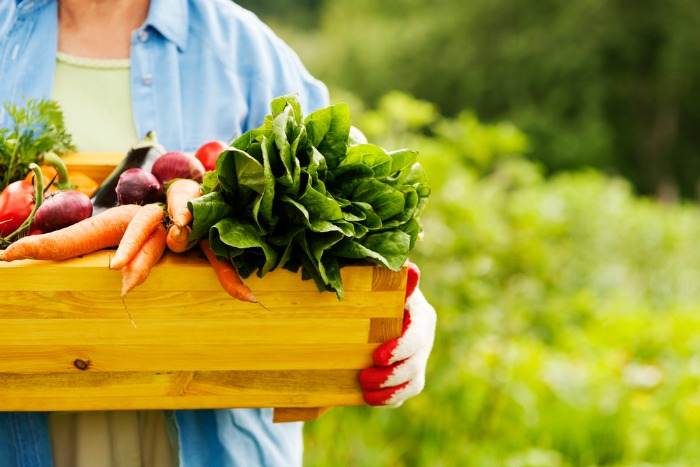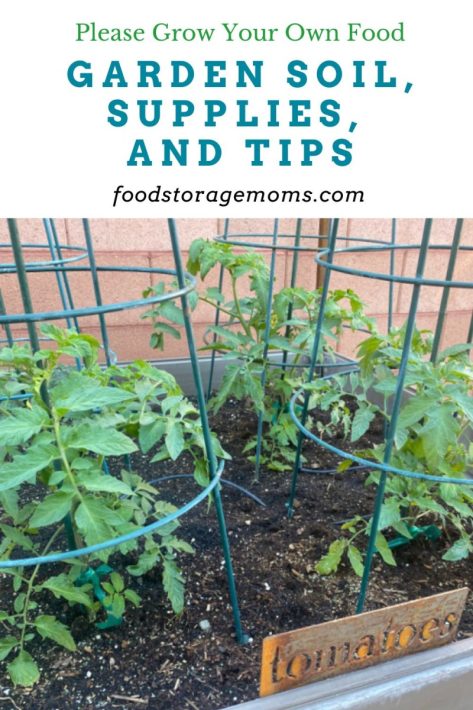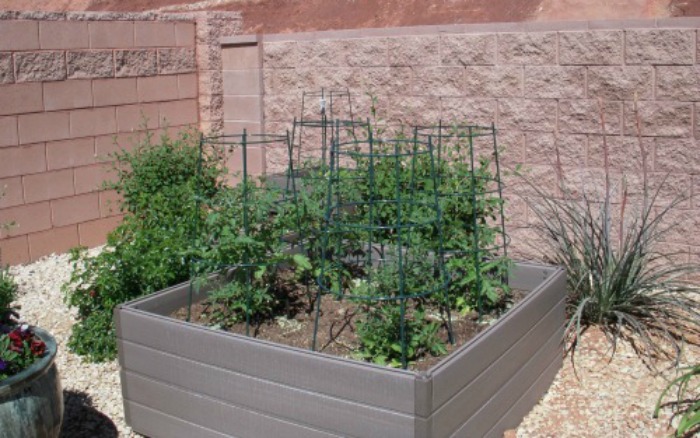
Have you always wanted to plant a garden but didn’t know where to start? Today, I want to walk you through what you need to grow a successful garden. How many of you have heard or said this statement, “What can I do to make my garden grow?”
Today, we will discuss what I know based on my experience and research. Of course, I would love you to share your ideas about how you grow your garden. Thanks in advance because we can all learn from each other. If I see “contaminated lettuce, spinach, etc. on the news, I want to scream!

Documentary I Recommend
If you haven’t watched the documentary “Poisoned: The Dirty Truth About Your Food” on Netflix and it may be streaming somewhere else, please do so. We must plant a small garden if that’s all we have room for. You can do it!
As you know, we moved up north in Utah, and the soil is better here, but the growing season is shorter than in Southern Utah. We must be ready to put our plants out by Mother’s Day; we shall see what the weather does this year. I need to decide what raised gardens I can afford and ask my grandsons to help fill them with good organic soil.
I decided I had to make a plan for my backyard so I could live off my land or at least try to live off my small plot of soil. I have had a garden for over 52 years, so I have learned the good, the bad, and whatever else about a garden. Today, I want you to consider growing a garden if you haven’t already done so. Let’s get the process started. Where I buy my garden seeds: SeedsNow
Garden Soil, Supplies, and Tips
1. Soil
The first thing we need to consider is our soil’s general condition and the perfect spot to grow fruits and vegetables. First, we need a lot of sunshine, so look for a great place in your yard. If you take a shovel and can’t dig very deep, your tomato roots can’t grow deep into the soil either.
I quickly learned that this beautiful red clay soil, which people love to admire and explore by hiking and biking all over the mountains of Southern Utah, is not the best soil for growing many plant varieties, or at least without some additives.
People love using manure, but I don’t have farm animals or a truck, so that won’t work for me. I know my soil is “clay” that can dry out very hard and clod up, so it is not the greatest for roots to grow deep down in the earth.
When we bought that house about 19 years ago, I tried growing tomatoes in 20-by-20-inch pots. I used a water drip system and everything else I was told to use to be successful. It didn’t work; the heat is too extreme for clay pot tomatoes. So, I checked that off my list.
But I learned I could grow potatoes in those vast pots a few years ago. It was a cartwheel moment for me when I dug my first potato! I was thrilled as I dug potato after potato and placed them in my hod basket. You need to understand: I have grown potatoes in large yards before, but I had a tiny yard there, and it was a bit trickier, but it can be done!
I soon realized that unless I bought a tiller (we sold our tiller years ago), we would not be able to grow any food items I desired in this hard cement-like clay soil. No, I’m not buying a tiller. I bought Miracle Grow soil and filled some raised garden beds, and the change in my success rate was terrific. Here are the depths you need for certain vegetables based on quality soils:
Shallow-rooted vegetables
Shallow-rooted veggies, such as lettuce, radishes, cauliflower, onions, chives, potatoes, and herbs, require a 12—to 18-inch soil depth for the roots to grow healthy and strong.
Medium-rooted vegetables
Medium-rooted vegetables, such as beans, cantaloupe, summer squash, and cucumbers, require an 18- to 24-inch soil depth for their roots to grow healthy and strong.
Deep-rooted vegetables
Sweet potatoes, tomatoes, and rhubarb are deep-rooted vegetables that need 24 to 36 inches of soil depth to grow healthy and strong. I have succeeded with my raised garden boxes with a soil depth of only 18 inches. I have found that I need to spread them out so they don’t conflict.
Can you see why people have to till gardens to loosen and make the soil loamy soil? I use a shovel and a rake in my raised garden beds. I have had a garden for 50 years with great soil, so I had to learn how to grow stuff here in Southern Utah.
Check the pH level
A worthwhile soil quality test is to check the soil’s pH level. The soil needs to be moist, and the probe needs to be clean and shiny. If it gets rusty, you can polish the probe with steel wool. Please remember to test several sections in your garden. Place the probe into the moist soil or water runoff and check the numbers. You can modify your soil type to grow your desired veggies if you know your soil type. Easy peasy.
Some plants prefer acidic soil, while others prefer alkaline soil. You can amend the soil with a few tips. Here are a few ideas for amending your soil: sawdust from untreated wood, shredded newspaper without the glossy pages, coffee grinds (fresh), two-year-old manure that’s been composted, etc. Be careful with coffee grinds; I put too much in and had to buy calcium to counteract it.
These are the pH numbers you want:
1. pH 7 is neutral soil
2. pH below 7 is acidic
3. pH above 7 is alkaline soil
2. Raised Garden Beds
The backup plan to using regular yard soil was to try raised garden beds. I decided to start with 18-inch-deep raised garden beds. Generally speaking, tomatoes need 24 inches for prime growth, but as mentioned, mine have 18 inches of root space, and they have grown very well.
I started with four raised garden beds, each 4 feet by 4 feet and 18 inches deep. Then, the next year, I bought two more raised gardens. I now have seven raised gardens. I purchased two more for next spring since they were on sale, and the company seems to be coming up with a newer style next year.
Yes, they are pricey, and you have to buy soil to put in them. As I stated above, I only buy Miracle Grow soil. They are raised beds 4 feet by 4 feet by 18 inches deep, and it takes 10 two-cubic-foot bags to properly fill them.
Yes, it’s not as cheap as using the regular soil in your yard, but I know I can grow my food in less-than-optimum soil and weather conditions. I bought mine over several seasons, so it worked well and was within my garden budget.
3. Fertilize Your Garden
I only use Miracle Grow fertilizer, but I had seven raised garden beds. I will see what I can put this year in the available space. It’s minimal.
4. Buy Heirloom/Organic/Non-GMO Seeds
Here’s the deal: starting with quality seeds or plants can produce much more in your garden. If you want to remember the term heirloom seeds, think pioneer. These seeds have been around for years and years. You can save and use the seeds each growing season with healthy plants. They might even pop up next spring without saving seeds. This is where I buy seeds: SeedsNow
Ballard’s Nursery ( LaVerkin, Utah) gave me a list of seeds and information about them. As always, I am condensing the list. I like the nitty-gritty, not a lot of fluff, so to speak. Here is my condensed list of seed information, simplified from Ballard’s:
Open-pollinated Seeds:
These seeds are produced by allowing many plants to cross-pollinate freely for several generations. Only similar plants can contribute pollen and make seeds for the next generation. The offspring that do not conform to the desired traits are culled before they can contribute pollen. These are the best seeds!
Hybrid Seeds:
These seeds are produced by crossing two open-pollinated varieties. The parent types are generally highly inbred so that they will express their genetic traits uniformly. Hybrids tend to be more vigorous than open-pollinated varieties (hybrid vigor). You can save seeds from hybrid plants, but because the parent plants are no longer inbred, their offspring may display various genetic traits, and the resulting crop may not be uniform.
Storing Seeds:
If you keep your seeds dry and as cool as possible, you can use the same seed (in most cases) for several years. Put them in an airtight container in the refrigerator or other cool storage areas (40-50 degrees storage temperature is ideal). Vacuum packing or freezing your seeds is unnecessary for good storage results. When you are ready to use the seed, remove the container from storage and let it warm up before opening to minimize condensation on the inside of the container.
Long-Lived Seeds:
These may be expected to maintain good viability for 5 years or more. Beets, broccoli, Brussels sprouts, cauliflower, cabbage, collards, kohlrabi, chicory, endive, escarole, radicchio, cucumber, kale, lettuce, melons, mustard, peppers, radish, rutabaga, sunflower, tomato, and turnip are examples.
Medium-lived seeds:
Beans, carrots, celery, chard, corn, eggplant, parsley, peas, pumpkin, and squash are in this category and may be expected to maintain good viability for 3 years.
Short-lived seeds:
These are generally not recommended for use for more than one season, but if kept cool and dry, they will usually still be acceptable in the second year. Leek, onion, parsnip, spinach, and cilantro are examples you can try.
5. Epsom Salt Helps Your Garden Grow
Epsom salt is excellent for tomatoes and peppers because they are usually magnesium-deficient. When planting tomato or pepper plants, you use one tablespoon per hole. As the tomatoes or peppers grow, we need to add one tablespoon of Epsom Salt per foot and work it into the soil.
Roses are usually magnesium deficient, so use one tablespoon per gallon and spray them if you think they need some magnesium. Epsom salt is also excellent for some flowering shrubs, like evergreens, since it improves the flowering process. I even use it on my trees. I learned it from my weed/fertilizer guy.
I had one tree struggling, and I added Epsom salt. The tree is green and doing very well. The mixture solution for trees is two tablespoons per nine square feet of the root base. I do this every three to four months. I also water my trees for one hour every two weeks in the summer and only once a month in the winter. Here again, this is why it’s critical we know our soil. If we test our soil, we will know what our plants need.
Epsom salt contains magnesium and sulfur, two essential nutrients for plants. Magnesium is found in chlorophyll that turns sunshine into food for our plants.
Garden Soil Amendments:
Garden soil is just like us in many ways. We will grow stronger if we eat the right foods. Your garden needs fertilizer or soil amendments such as these:
- Azomite Micronized Bag, 44 lb
- Earthworm Castings Organic Fertilizer, 15-pound
- Organic Bone Meal, 3 lb
- Organic Vermiculite
Tomato Cages
Here is a picture of my raised garden beds and the tomato cages I purchased from Glover Nursery in South Jordan, Utah. I have had these for at least 15 years; they do not fall apart. They are the only ones I will buy. If you live near this nursery, I highly recommend this brand called “Sturdy Cages.”

Tomato and Pepper Blossom End Rot (brown spot):
This disease is usually caused by too much water (overstressed) or too much nitrogen. Plants need calcium because they have a calcium deficiency.
Your tomato plants need calcium. You can buy a spray when the flowers first appear, or you can add crumbled eggshells deep into the soil to help with the calcium levels. Again, we need to check our pH levels.
Final Word
Please plant a garden; I feel an urgency to ensure people learn to produce their own food. If you have access to a community garden, that would be awesome. I’m lucky to have a small yard where I can produce enough vegetables for our family using the space in my backyard. Please be prepared for the unexpected. May God Bless this world, Linda
Copyright Images: Senior Woman Holding Garden Box Depositphotos_21909131_S By Gpointstudio,
The post Garden Soil, Supplies, And Tips appeared first on Food Storage Moms.
from Food Storage Moms
No comments:
Post a Comment